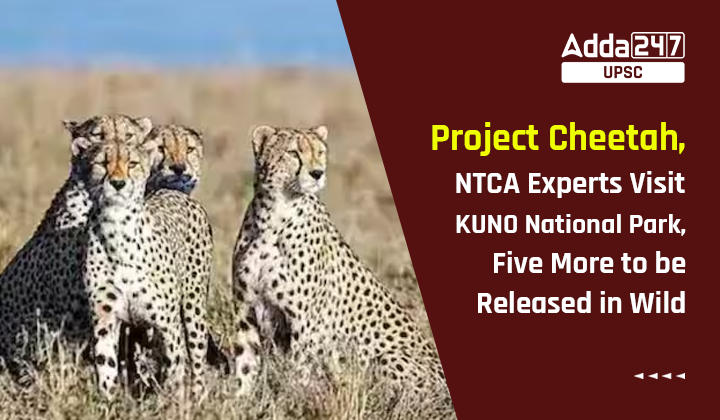Table of Contents
Project Cheetah: it is a cheetah reintroduction policy of the Indian Government to ensure sustainable habitation of Cheetah in India. Cheetah Reintroduction is also important for UPSC Prelims Exam 2023 and UPSC Mains Exam (GS Paper 2- Environment and Ecology)
Project Cheetah in News
On the directions of the National Tiger Conservation Authority (NTCA), a team of experts visited the Kuno National Park on 30 April, 2023 and reviewed the current status of the Project Cheetah.
Expert Report on Project Cheetah
After examining all aspects of the project cheetah, the team submitted a detailed report on the next steps.
- They noted that in the first phase of the ambitious project aimed at reintroducing cheetahs to their historical range in India, twenty cheetahs were successfully translocated from southern Africa to Kuno National Park (KNP) in September 2022 and February 2023.
- The majority of cheetahs were observed and assessed by the team from a safe distance, while they also reviewed the existing procedures and protocols for managing these animals.
- All of the cheetahs were found to be in good physical health, exhibiting their natural behaviors such as making kills at regular intervals.
- This project aims to support worldwide cheetah conservation initiatives by securing legally protected areas that cover a total of 100,000 square kilometers of habitat, and by providing an additional 600,000 square kilometers of suitable landscape for the species.
Steps to be Taken for Further Cheetah Reintroduction
After discussion with the Forest Department officials in KNP they agreed on the next steps to be taken going forward.
- Five more cheetahs (three females and two males) will be released from the acclimatisation camps into free-roaming conditions in KNP before the onset of the monsoon rains in June.
- Individuals were chosen for release based on their behavioural characteristics and approachability by the monitoring teams.
- These released cheetahs will be monitored in the same way as those that have already been released.
- The remaining 10 cheetahs will remain in the acclimatisation camps for the duration of the monsoon season.
- Certain internal gates will be left open to allow these cheetahs to utilise more space in the acclimatisation camps and for interactions between specific males and females to take place.
- Once the monsoon rains are over in September, the situation will be reassessed. Further releases into KNP or surrounding areas will be done in a planned manner to Gandhisagar and other areas as per the Cheetah Conservation Action Plan to establish meta population.
- Cheetahs will be allowed to move out of KNP and will not necessarily be recaptured unless they venture into areas where they are in significant danger.
- Their degree of isolation will be assessed once they settle down and appropriate action will to be taken to enhance their connectivity to the group.
- The female who gave birth in March, will remain in her camp to hunt and raise her four cubs.
Tracing the Re-introduction of Cheetahs in India
- Beginning: The State Wildlife Board of Andhra Pradesh was the first to suggest the policy in 1955, on an experimental basis in two districts of the state.
- Government on Re-introduction: In the 1970s, the Department of Environment formally requested Iran, which had 300 Asiatic cheetahs at the time, for some cheetahs.
- However, the Shah of Iran was deposed before any deal could be reached.
- Revival of Demand: Attempts to bring cheetahs to India were revived once more in 2009, and the Wildlife Trust of India conducted a meeting to discuss the feasibility of cheetah reintroduction.
- Several sites were chosen, of which Kuno-Palpur National Park was seen as the most suitable.
- This was because the area had a large habitat area available and significant investments had already been made to displace the villagers inhabiting the site.
- Supreme Court on Reintroduction of Cheetah: The Supreme Court in 2010 stayed the order to reintroduce cheetah to Kuno- Palpur because the National Board for Wildlife had not been privy to the matter.
- The court said that priority should be given to the reintroduction of the Asiatic lion, which is only found in Gir National Park, Gujarat.
- In 2020, while responding to a plea by the government, the Supreme Court announced that African cheetahs could be introduced in a “carefully chosen location” on an experimental basis.
- Re-introduction of Cheetah: recently PM Modi released three of eight cheetah in the Madhya Pradesh’s Kuno National Park.
- These cheetah were flown from Namibia’s capital Windhoek.
- Among eight wild Cheetahs that were brought to India, five are females and three are males.
Cheetah in India, Tracing the Extinction Journey of Cheetah in India
- Hunting with the cheetahs: The cheetah, which was relatively easy to tame and less dangerous than tigers, was frequently used by Indian nobility for sport-hunting.
- The earliest available record for cheetahs being used for hunts in India, comes from the 12th century Sanskrit text Manasollasa, which was produced by the Kalyani Chalukya ruler, Someshvara III (reigned from 1127-1138 CE).
- Emperor Akbar, who reigned from 1556-1605, was particularly fond of the activity and is recorded to have collected 9,000 cheetahs in total.
- Emperor Jahangir (ruled from 1605-1627) took after his father and is said to have caught more than 400 antelopes by cheetah coursing in the pargana of Palam.
- The capture of wild cheetahs for hunting and the difficulty to breed them in captivity was leading to a decline in the cheetah population, even before the entry of the British.
- Near extinction under the British Raj: they preferred to hunt big game, such as tigers, bison and elephants.
- Under the British Raj, forests were extensively cleared, so as to develop settlements and to set up indigo, tea and coffee plantations.
- This further resulted in the loss of habitat for big cats, contributing to their decline.
- British officials considered the animal as “vermin” and also distributed monetary rewards for the killing of cheetahs from at least 1871 onwards.
- The rewards for bounty hunting likely caused the decline of cheetahs, as even the removal of a small number would have negatively affected the ability of wild cheetahs to reproduce even at the lowest level required for survival.
- As a result, wild cheetahs became very rare in India by the 20th century.
- Extinction of Cheetah from India: In 1952, the Indian government officially declared the Cheetah extinct in the country.
- Maharaja Ramanuj Pratap Singh Deo of Korea, Madhya Pradesh, is widely believed to have killed the last three recorded cheetahs in India in 1947.
Project Cheetah Details
- Project Cheetah: India is undertaking the world’s first intercontinental large wild carnivore translocation project to reintroduce cheetahs to the country.
- Coexistence approach:Unlike previous cheetah reintroduction efforts, India’s approach is unique in that it aims to reintroduce the cheetah in an unfenced protected area using a coexistence approach.
- Significance of Coexistence approach:This approach is favored by social scientists, as fencing has been successful in eliminating cheetahs’ tendency to range over wide distances in other countries, limiting population growth. Additionally, Kuno NP’s core conservation area is largely free of human-made threats.
- Challenges associated with Coexistence approach:Reintroduction to Kuno NP will be challenging, as the park is unfenced and there have been no successful reintroductions into unfenced systems. Anthropogenic threats like snaring for bush meat and retaliatory killings due to livestock depredation pose risks to the cheetahs.
- Fortress conservation:While cheetahs have been reintroduced in fenced protected areas in various African countries, India’s coexistence approach presents a new frontier for conservation efforts.
Significance of Cheetah Reintroduction
The restoration of cheetahs in India is anticipated to improve the overall health of the ecosystem due to their distinctive ecological role in the carnivore hierarchy. In addition, their charismatic nature can be leveraged to advance the country’s conservation objectives by enhancing protection efforts and promoting ecotourism in areas that have been previously overlooked.
19th Meeting of NTCA: 50 Cheetah to be introduced in next 5 years





 TSPSC Group 1 Question Paper 2024, Downl...
TSPSC Group 1 Question Paper 2024, Downl...
 TSPSC Group 1 Answer key 2024 Out, Downl...
TSPSC Group 1 Answer key 2024 Out, Downl...
 UPSC Prelims 2024 Question Paper, Downlo...
UPSC Prelims 2024 Question Paper, Downlo...




